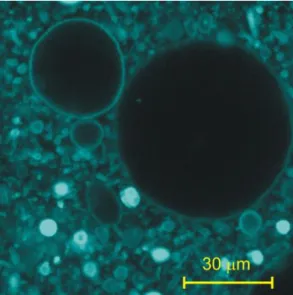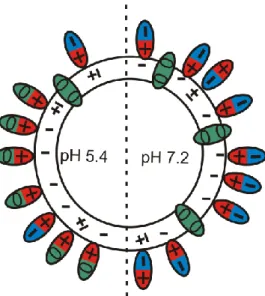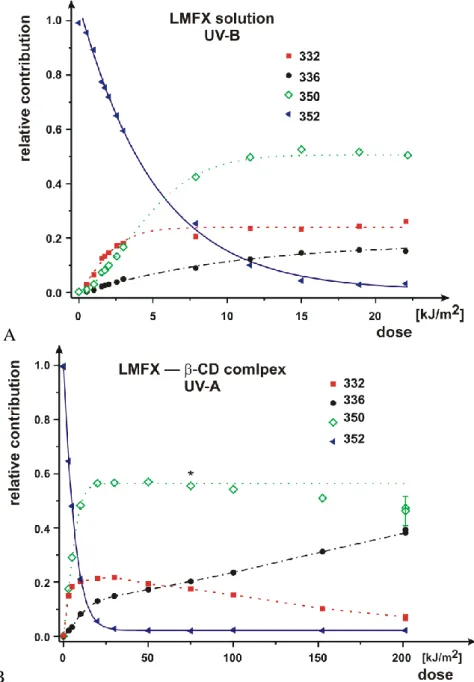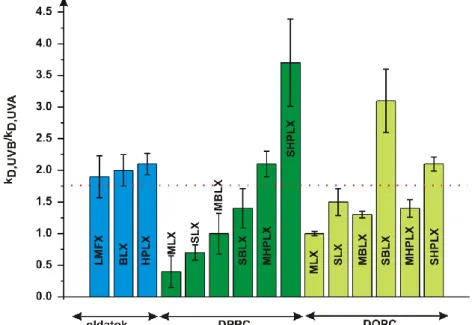Interactions in liposomal systems in nano- and cellsize
PhD Thesis
Nóra Mike-Kaszás
Semmelweis University Pharmaceutical Sciences
Supervisor: Dr. Pál Gróf, C.Sc.
Reviewers: Dr. Romána Zelkó, D.Sc.
Dr. Kornélia Farkas, PhD.
Chairman of the examination committee: Dr. Emil Monos, D.Sc.
Members of the examination committee: Dr. Ferenc Csempesz, C.Sc.
Dr. Tamás Mészáros, Ph.D.
Budapest
2013
1
1. Introduction
The liposomal researches basically involve two important topics. First, liposomes can be used as membrane models: thus the properties of membranes can be studied under more precisely defined conditions. On the other hand, liposomes have been recognized as favorable drug delivery systems soon at the very beginning. Different types of liposomes can be distinguished according to their size and structure. These different types can be suitable for the encapsulation of active substances with different properties, and can be administered in different ways (internally, externally). The available liposomal products contain mostly small and large unilamellar vesicles (SUV, LUV) with a maximal diameter of a few hundred nm.
Multilamellar and giant vesicles (MLV, GUV) possessing larger diameter can be administered per os for the cure of gastrointestinal disorders or topically (e.g. in ophthalmology, dermatology). Giant vesicles were used primarily as model membranes in research; as drug delivery systems their properties were rarely investigated. Selecting the most suitable type of liposomes for the encapsulation of a drug, besides the mode of administration, depends on the localization of the drug in the vesicle, that is influenced mainly by the physical-chemical properties of the drug, like the molecule size, its charge and logP value and its interaction with lipid molecules. In case of the incorporation of lipophilic active ingredients higher encapsulation efficiency can be reached by the application of MLVs possessing higher lipid ratio. The higher ratio of aqueous to lipid phase favors the encapsulation of water-soluble substances. There is a difference also in the curvature of small and giant vesicles that manifests in the package of lipid molecules and their interactions. Consequently, there can be a difference in the binding of drugs and in the resistance against external impact (e.g.
enzymes, bile acids). The intake of an active ingredient or an auxiliary material into a liposomal system can provoke changes in the properties of both the active ingredients and the liposomes. For example, the surface charge density and fluidity of vesicles can be changed, that can influence the vesicle stability and the release of the active ingredient from the product, moreover also the apparent solubility, the stability or the photosensibility of the enclosed molecule can change. The lipid solubility of drugs can be enhanced not only by the composition of lipids, but also by addition of auxiliary materials. Different cyclodextrines, used also as drug delivery systems alone, can behave as such excipients, but there are only a very small number of studies which examined the potential beneficial properties of the combined cyclodextrin−liposome systems. With the experiments presented in my thesis I aimed at studying some basic properties of giant vesicles, the impacts of the interactions of
2
the different drugs and the liposomal drug delivery systems on some physical-chemical properties.
2. Objective
During my work I investigated liposomes of different size and structure, their interaction with model drug molecules. I studied the encapsulation of two types of drugs (neutral and charged) into vesicles with different lipid composition and size, especially with giant vesicles.
The main goals of my works presented in the thesis were:
1. Optimization of preparation conditions of giant vesicles to produce samples suitable primarily for spectroscopic measurements.
2. Investigation of the incorporation of model drug molecules (charged fluoroquinolones, neutral caffeine) into liposomes with different size and lamellarity.
3. Characterization of the membrane fluidity by EPR spectroscopy in the presence of ciprofloxacin or caffeine.
4. Characterization of the changes of the surface charge density due to the interaction between the lipid molecules of the model membranes and the incorporated model drugs.
5. Investigation of the differences in the physico-chemical properties in the caffeine−liposome systems due to saturation of the lipid molecules present in the liposomal membranes.
6. Determination and description of the permeability of the liposomal membrane for model drug molecules on the basis of dialysis measurements using appropriate theoretical model.
7. Study on the photostability of the lomefloxacin irradiated in UV-A and UV-B region in the presence of combined liposomal-cyclodextrin formulations
3
3. Methods
Preparation of liposomal samples. For the preparation of liposomes egg and soy bean lecithin, L-dipalmitoyl-phosphatidylcholine (DPPC), dimyrisztoil- phosphatidylglycerol (DMPG) and dioleoyl-phosphatidylcholine (DOPC) were used. Multilamellar vesicles (MLV) were produced by thin-layer hydration method, small unilamellar vesicles (SUV) were prepared by extrusion or sonication from MLVs. The formation of giant vesicles (GUV) was carried out by the gentle hydration under different lipid and buffer conditions. Experiments were done at two pH values: at pH 5.4 and pH 7.2.
The quality of GUVs was checked by confocal microscopy. For the determination of encapsulation efficiency samples were centrifuged through a filter with appropriate pore size, then the concentration of the drug in the filtrate was measured. The change of fluidity and surface charge density caused by the active ingredients were determined by electron paramagnetic resonance (EPR) spectroscopy (Bruker-EMX-6) and zeta-potential measurements (Zetasizer Nano ZS, Malvern Instruments Ltd.). The drug release of MLVs and GUVs was carried out by dialysis.
The ratio of photodegradation products of lomefloxacin (LMFX) was determined in lomefloxacin-cyclodextrin-liposome systems. For the complexation of LMFX -cyclodextrin (B-CD) and 2-hydoxypropyl--cyclodextrin (HP-CD) were applied. The hydration of DPPC or DPPC/DOPC (70/30) lipid films was carried out with the solution of LMFX or of the complexes. VL-UVA, T-15.L and FS20 lamps were used as UV-A and UV-B sources. The dose and intensity of irradiation was measured by CX-365 and CX-312 sensors attached to a VLX-3W type dosimeter. The photoproducts of different masses were measured by an Agilent 1260 HPLC attached to a 6460 QQQ mass spectrometer. To determine the photodegradation rate constant (kD) of the LMFX experimental data were fitted using Weibull-function.
4
4. Results
Preparation of giant vesicles. We succeeded in optimizing the conditions to prepare giant vesicles suitable for spectroscopic purposes containing egg lecithin or mixture of DPPC/DMPG (90/10). According to our results for the formation of GUVs the higher pH (>~
pH 7.0), the presence of charged lipids and a calcium-free buffer (20 mM sucrose, 0,1 mM EDTA, 20 mM TRIS) are optimal. The quality of GUV samples was checked by confocal microscopy (Fig. 1.)
Encapsulation efficiency (EE). No difference was measured in the EE of CPFX in case of GUVs made of egg lecithin or DPPC/DMPG (90/10). EE was nearly the same on both pH values (pH 5.4 és 7.2). Binding capacity of liposomal systems can be expressed as specific EE, the EE relative to lipid concentration. The binding capacity was 20.5 enclosed-drug- percentage/(mg/ml lipid) of GUVs and 3.4 enclosed-drug-percentage/(mg/ml lipid) of MLVs.
The presence of unsaturated lipids did not affect the encapsulation of caffeine; EE was ~ 30 % in case of soy or egg lecithin MLVs.
Fig. 1. Confocal image of GUVs made of egg lecithin at pH 7.2. (0.1 mol%
Rhodamin-labelled lipid)
Effect of the presence of drugs on the properties of liposomes. The fluidity of egg lecithin liposomes increased in the presence of CPFX in the region between the head groups and fatty acids above 39 oC. Increasing the temperature further on, the rate of fluidity-change decreased, that indicates that due to the thermal motion of the lipid molecules the membrane fluidity can be less modified by the effect caused by CPFX. In case of egg and soy lecithin liposomes encapsulating caffeine, no change was observed neither in the depth of the fifth carbon atom, nor at the interphase of the lipid membrane and the aqueous phase.
5
CPFX had different effect on the surface charge density of egg lecithin vesicles at the two pH values, although the EE was nearly the same. The zeta potential of vesicles was negative at both pH values: -18 and -30 mV at pH 5.4 and at pH 7.2, respectively. The addition of CPFX to the liposomal system caused the decrease of the absolute value of zeta potential at pH 5.4, thus led to the decrease of the electrostatic repulsion between lipid bilayers and vesicles. This effect was observed also in the microscopic images: vesicles had smaller diameter and partially multilamellar structure locating in clusters. At pH 7.2 no change was observed in zeta potential or in the images. Nor the addition of caffeine had influence on the surface charge density of vesicles. This phenomenon can be explained by the different charge of the two model drug molecules. The different microspecies of CPFX molecules have different contributions at different pH values. At the lower pH value 80 % of CPFX molecules have positive charge, while at the higher pH value more than 60 % of them have zwitterionic form. Thus, molecules turn their positive moiety toward the negative charge of vesicles shielding it at pH 5.4, while at pH 7.2 no change can be observed, hence the net charge of the vesicles remains negative (Fig. 2). The similar EE measured at different pH values can be explained by the different contribution of microspecies encapsulated into the liposomes and the change measured in zeta potential.
Fig. 2. The binding of CPFX to liposomes at the two observed pH values. +, 0 and – denote the charges of CPFX molecules.
Caffeine is neutral at the pH of measurement (pH 5.6), thus it did not provoke change in the surface charge density of vesicles.
Drug-release of MLV and GUV examined by dialysis. 97 % of the amount of CPFX was released from MLVs in the dialysis tube that could come from the extra- and intraliposomal volume and from molecules bound to the lipid molecules. In the case of egg lecithin GUVs
6
the released amount was 70 %. The three-compartment model considers separately the diffusion of drug through the liposome and the dialyzing membrane. Evaluating the results we found that the half-life time of CPFX diffusion through the GUV membrane was longer (54 hours), that that through MLV membrane (18 hours). These half-lives can be explained by the different enclosed aqueous volumes, amount of molecules bound on the surface, by the structure of lipid membranes and by the different ratios of the lipid/aqueous phases in GUVs and MLVs.
Investigation of the photosensitivity of lomefloxacin (LMFX) in cyclodextrin and cyclodextrin-liposome systems. Contribution of photoproducts with different masses (m/z=332, 336, 350) plotted as the function of UV-B dose saturated. Applying higher dose UV-A radiation after a certain dose the contribution of photoproducts showed transient characteristics (Fig. 3.).
Differences were observed in the degradation rate constant of LMFX after the irradiation of the two kind of light sources. No relevant change was measured in the value of kD (except two liposomal samples containing HP-CD) referred to the LMFX solution after irradiation by the UV-B source. In case of UV-A irradiation the kD values of liposomal samples were always higher than that of samples containing 30 % DOPC. LMFX suffered its fastest photodegradation incorporated into DPPC liposomes irradiated by UV-A, but the the presence of cyclodextrines slowed it down. The complexation of LMFX by cyclodextrines (with no lipid) enhanced the photodegradation of the drug in case of UV-B, but no effect was observed after the irradiation with UV-A.
7 A
B
Fig. 3. The contribution–dose curves of LMFX and its photoproducts in case of UV-B irradiation of LMFX solution (A) and UV-A irradiation of LMFX–BCD complex (B). In case of UV-B irradiation the contribution of photoproducts saturated, while in case of UV-A radiation contributions increased continuously (m/z= 336) or decreased (m/z=
350, 332).
According to Fig. 4. most of the liposomal samples were more sensitive to UV-A, than to UV-B, while SUVs were always more sensitive to UV-B, than MLV samples with the same composition.
8
Fig. 4. Ratio of degradation rate constants corresponding to UV-B and UV-A radiation. LMFX is more sensitive to UV-B if the ratio is over 1.75.
LMFX: LMFX solution, BLX/HPLX: comlex of -CD/HP--CD and LMFX, M/S: MLV/SUV, DPPC: liposomes prepared from DPPC, DOPC: liposomes containing DOPC in 30 mol%.
9
5. Conclusions
During my work I investigated the optimal conditions of giant vesicles formation, the binding of model drug molecules to vesicles of different structure, the change of zeta potential and fluidity in membranes due to binding and the potential protective effect of liposomal- cyclodextrin systems on photodegradation of an active ingredient.
Based on my results I make the following conclusions:
1. For the preparation of egg and soy lecithin GUV samples suitable for spectroscopic purposes low ionic strength and bivalent cation concentration below 1 mM are favorable. The optimal cation concentration can depend on the presence of lipid molecules possessing negative charge.
2. According to the results of binding measurements done on multilamellar vesicles similar encapsulation efficiency can be achieved with the two model molecules: the charged ciprofloxacin and the neutral caffeine. Giant vesicles have higher specific binding-capacity for hydrophilic drugs (CPFX), than multilamellar vesicles have.
3. The binding of a neutral molecule (caffeine) has no impact on the surface charge density of vesicles, despite of the formed hydrogen-bonds. Drug molecules possessing different contributions of microspecies can influence the zeta potential depending on the pH. Hence, to maintain or to increase the stability of a liposomal product the use of such a derivative of the active ingredient that maintains the value of zeta potential is favorable. Also the application of charged lipids can solve this problem.
4. Based on EPR spectroscopy measurements incorporation of caffeine does not have an impact on membrane fluidity in the region of polar head groups, while CPFX increases fluidity above 39 oC. The addition of an active ingredient into the liposomal system can influence the fluidity; hence it can modify the expected release behaviour of the drug delivery system. In some cases the change caused in fluidity can be temperature-dependent that can be advantageously used for appropriate treatments.
5. Drug release is influenced by the charged/uncharged forms of drugs, their binding to the vesicle, as well as by the structure and enclosed aqueous volume of the vesicle. The diffusion rate through the liposomal membrane can be determined by dialysis measurements, if the used dialysis model considers the volume of the
10
enclosed aqueous phase, the amount of drug bound to the lipid membrane and if necessary the inhomogeneous sample-taking. For the selection of the drug delivery system of optimal encapsulation capacity and optimal release rate, the determination of partition and permeability properties of the drug in the proper liposomal formulation is crucial.
6. The results of experiments show that the degradation of a photosensible drug, lomefloxacin (LMFX) can be influenced by the encapsulation of LMFX- cyclodextrin complex into liposomes. Not only the presence of liposomes impacts the photodegradation of LMFX and the spectral sensitivity of the degradation rate constant, but also the type of cyclodextrins and the structure and composition of liposomes being present together with CDs. These indicate that the special interaction between LMFX/photoproducts and CDs or lipids can change the electron distribution in the LMFX and the photoproducts, that is crucial in the process of photodegradation. According to my observations to decrease the degradation rate of LMFX and possibly the phototoxic side effects the application of small unilamellar vesicles (SUV) containing DOPC can be promising.
11
6. Publication list
Publications corresponding to the thesis
Kaszás N, Bozó T, Budai M, Gróf P. (2013) Ciprofloxacin encapsulation into giant unilamellar vesicles: Membrane binding and release. J Pharm Sci, 102: 694-705.
IF: 3,13
Budai L, Kaszás N, Gróf P, Lenti K, Maghami K, Antal I, Klebovich I, Petrikovics I, Budai M. (2013) Liposomes for topical use: Physico-chemical comparison of vesicles prepared from egg or soy lecithin. Sci Pharm, 81: 1151-1166.
Kaszás N, Budai M, Budai L, Gróf P, Zimmer A, Klebovich I. (2008) A bezárási hatásfok növelésének lehetőségei liposzómába zárt lomefloxacinnál. Acta Pharm Hung,
78: 69-74.



